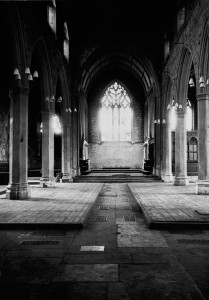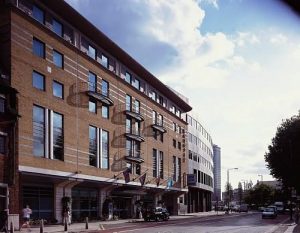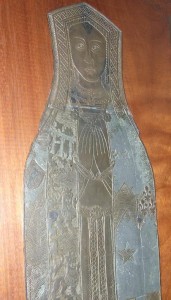
Following on from Linda’s article on the resting place of Elizabeth Boleyn (née Howard) at Lambeth, Marilyn Roberts sent me the following article as the Howards are her area of expertise and she has spent considerable time researching them.
More on the Howard Chapel and Norfolk House, Lambeth
by Marilyn Roberts
I was really pleased to read Linda Saether’s article and glad that she had such a heartening experience at the Garden Museum in Lambeth. A few years ago I wrote a book on the Mowbray family, the original Dukes of Norfolk from whom the Howards are descended (www.queens-haven.co.uk), which is coming up for revision shortly. Three years ago I decided to follow-up on Mowbray and Howard London connections, which I saw as providing material for an appendix, and now, over 50,000 words later, I have the makings of another book!
As Linda would probably tell you, Lambeth in general is now not the most quaint of places, and it is difficult to equate the Novotel and neighbouring buildings on Lambeth Road and the small recreation ground behind them with what was once a Tudor mansion, Norfolk House, set in acres of garden and orchards where the young Katheryn Howard strolled with her paramours; even Costa Coffee’s roasting works stands beside the railway arches carrying trains to Waterloo Station.

The Novotel at 113 Lambeth Road is in the foreground, with the premises of the Royal Pharmaceutical Society of Great Britain alongside; Norfolk House itself stood where the hotel is now. The tree to the right blocks the view of Lambeth Palace and the Howards’ local church, now the Garden Museum.
I started off looking at the archaeology of the house itself but was drawn in by the people, especially Agnes Tilney, Katheryn Howard’s step-grandmother, whom I now believe has had a raw deal over the centuries. She is generally reviled for having run a lax household, but actually appears to have done her best to keep her house in order.
So little is really known about Katheryn’s life at Norfolk House, and we have to remember that what we do have is very biased and all from the same source. It was written down and became public knowledge, not at the time it was happening, but after falling from the mouths of those of her terrified former companions being interrogated in the late autumn and early winter of 1541/42 with varying degrees of severity, and all out to save their own skins.

Philip Norman and I discussed at the Garden Museum last autumn how erroneous information can become part of the supposed fund of true knowledge, a good example of which is the information that usually accompanies the Katherine Howard brass at Lambeth. We are told that she was the wife of Lord William Howard and was imprisoned with him in the Tower in 1541 for having concealed knowledge of Queen Katheryn Howard’s misdemeanours; this cannot be true as this lady died in 1535. The Lady Howard in the Tower was Lord William’s second wife, Margaret Gamage, and the misinformation has been handed down and not questioned since it was published in eighteenth-century histories – by eminent historians of the day, no less! This Katherine is also referred to as Lady Effingham, but her husband did not receive the manor of Effingham in Surrey until 1551, and did not become Lord Howard of Effingham until 1554, nearly twenty years after her death. Norfolk House itself is sometimes said to be in the county of Norfolk, instead of in Lambeth, and you can find examples of this sort of thing all the time. The worst ‘sin’ as far as I am concerned is the glib assertion, often by people who should know better, that Queen Katheryn was raised in Lambeth Palace, the home of the Archbishop of Canterbury. Don’t get me started on that one!
Like some of the comments on Linda’s article suggest, it could feel uneasy or disrespectful to be drinking coffee in the Howard Chapel café with the possibility that Duchess Agnes and her step-daughter Elizabeth Boleyn could be lying a few inches beneath your feet, but I don’t think we should be too hard on the Garden Museum for its present use of the premises. Although much of the tower is original, it was the Victorians who recklessly demolished and rebuilt the church of St Mary-at-Lambeth, and showed no respect at all for its Howard burials, smashing their way through tombs and memorial tablets. The church was deconsecrated in the 1970’s and was due for demolition when it was rescued almost at the last moment and became the Museum of Garden History (now the Garden Museum), so actually we should be grateful the museum is there. We should also be grateful for Philip Norman, mentioned by Linda, who, for the enthusiasm with which he guards the memories and few remaining treasures of this building, should be seen as a treasure in his own right.
To Linda Saether: congratulations on having done such a good job in a short time. Maybe one day we can meet in the Howard Chapel café and raise a glass of something to the memory of the noble ladies at rest beneath our feet.
(Marilyn Roberts is a freelance writer and lecturer. She is also Collections Care Co-ordinator at Epworth Old Rectory Museum, North Lincolnshire, the childhood home of John and Charles Wesley.)
See Dr Linda Saether’s article “Searching for the Grave of Elizabeth Boleyn, Countess of Wiltshire”.
Thank you so much for this informative article and the wonderful compliment. Yes, maybe we could meet some day at the Howard Chapel and raise a toast to the Howard ladies!
I saw your book on your site and hope to read it very soon!
The more I read on this site and the Elizabeth I files, the more I need to walk in these places, see them for myself, touch the walls, and “feel” the presence of these Ladies we all are so enthralled with and “live” with daily. Somehow, someway, I shall do so before I draw my last breath!
Now if I could just find time to finish the research I’m doing on Anne and finish the essay I’m writing. Oh, to have just 2 more hours a day.
Marlyn and Linda,
you two need to get together over a coffee (but maybe not over a Howard!)
The attitude of the 70’s was pretty much “out with the old, in with the new” the world over.
Funny though, her husband is in St.Peter’s in Hever and his Crypt is untouched by time.
There is a bit of an “I told you so” going on in the Boleyn heavenly household!
Such a strange place to put a coffee shop. Of course this problem is not a big one in southern California because there was not a whole lot worth preserving. Frank Lloyd Wright built some houses on unstable land. After taking a tour of one, all I can say is that England certainly had a lot more interesting buildings than all of California combined. I suppose some would have to suffer to make way for more modern buildings.
This is fasinating. I have a direct line descendant of Thomas Howard!
Thank you for this information. Elizabeth (Howard) Boleyn via Mary Boleyn is a direct descendent of mine. I shall visit The Garden Museum soon; it is only a few miles from where I live.
I’m so delighted to find all this information about a brass-rubbing I made in the 60’s. I’ve always loved this depiction and thought I remembered it as being in Lambeth Palace – well close! I imagine brass-rubbings are no longer permitted. I have some from Westminster Abbey from the same period also.
When did the Howard mansion vanish? I am interested if there is any overlap with Vauxhall Pleasure Gardens and the Tyers as I think Hogarth did a supper box mural about Henry VIII and Anne Boleyn.
I know this area, from Costa to the Garden Museum very well and little survives even of the Victorian graveyard. Mary
I see elsewhere that a ledger stone has been moved within the church and is now visible in the floor near the gift shop. The pictures I have seen have the inference is that it is the gravestone of Elizabeth Howard Boleyn. There is a picture on the Tudor Trail website. However, although the inscription on the photo is not at all clear it does not appear to mention the name Boleyn or Wiltshire, and Elizabeth would surely be buried under those names, not as Elizabeth Howard? Clare or Marilyn – have you seen the stone? What does it actually say – I can make out “Here lyeth the” then there is a wide crack and what may be part of the word body – then what may be “Elizabeth” and on the next line “Howard” but the rest is hard to make out.
I intend to go to London shortly and will try to visit, though covid has made things difficult!